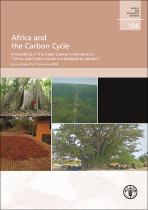 ResearchSpace
ResearchSpace
Estimation of net ecosystem exchange at the Skukuza flux site, Kruger National Park, South Africa
JavaScript is disabled for your browser. Some features of this site may not work without it.
- ResearchSpace
- →
- Research Publications/Outputs
- →
- Conference Publications
- →
- View Item
| dc.contributor.author |
Nickless, A

|
|
| dc.contributor.author |
Archibald, SA

|
|
| dc.contributor.author |
Van der Merwe, Martina R

|
|
| dc.contributor.author |
Scholes, RJ

|
|
| dc.contributor.author |
Williams, CA

|
|
| dc.contributor.author |
Hanan, N

|
|
| dc.date.accessioned | 2011-08-29T13:10:48Z | |
| dc.date.available | 2011-08-29T13:10:48Z | |
| dc.date.issued | 2011-03 | |
| dc.identifier.citation | Nickless, A, Archibald, SA, Van der Merwe, M, et al. 2010. Estimation of net ecosystem exchange at the Skukuza flux site, Kruger National Park, South Africa. Africa and the Carbon Cycle: Proceedings of the Open Science Conference on "Africa and Carbon Cycle: the CarboAfrica project". 25-27 November 2008, Accra (Ghana), pp. 240 | en_US |
| dc.identifier.uri | http://hdl.handle.net/10204/5135 | |
| dc.description | Africa and the Carbon Cycle: Proceedings of the Open Science Conference on "Africa and Carbon Cycle: the CarboAfrica project". Accra (Ghana), 25-27 November 2008 | en_US |
| dc.description.abstract | Annual estimates of gross primary production (GPP) and ecosystem respiration (Reco) were obtained for the Skukuza flux site, Kruger Park, South Africa, based on the eddy covariance flux data. A new method of extrapolating night-time respiration to the entire day and filling gaps in eddy-covariance data in semi-arid systems was developed. The purpose for developing this method was to better account for the manner in which net ecosystem exchange (NEE) in drylan systems occurs as pulses driven by rainfall events, compared to current standard interpolation procedures developed primarily for temperate flux sites. The standard techniques furthermore do not take into account the decrease in respiration at very high soil temperatures. An artificial neural network (ANN) model was used to model GPP and Reco by incorporating fraction absorbed photosynthetically active radiation (fAPAR), the timing and magnitude of rainfall events, and temperature. The ANN predicted measured fluxes accurately (MAE 0.42 gC/m2/day), and was able to represent the seasonal patterns of photosynthesis and respiration at the site. The annual integral of the filled NEE data was found to range from -138 to +155 g C/m2/y over the five years eddy covariance measurement period. A full explanation of the methods and a full analysis of the data can be found in Archibald et al. (2009). | en_US |
| dc.language.iso | en | en_US |
| dc.relation.ispartofseries | Workflow;5542 | |
| dc.subject | Eddy covariance | en_US |
| dc.subject | Interpolation | en_US |
| dc.subject | Partitioning | en_US |
| dc.subject | Gap-Filling | en_US |
| dc.subject | Net Ecosystem Exchange (NEE) | en_US |
| dc.subject | Kruger National Park | en_US |
| dc.title | Estimation of net ecosystem exchange at the Skukuza flux site, Kruger National Park, South Africa | en_US |
| dc.type | Conference Presentation | en_US |
| dc.identifier.apacitation | Nickless, A., Archibald, S., Van der Merwe, M. R., Scholes, R., Williams, C., & Hanan, N. (2011). Estimation of net ecosystem exchange at the Skukuza flux site, Kruger National Park, South Africa. http://hdl.handle.net/10204/5135 | en_ZA |
| dc.identifier.chicagocitation | Nickless, A, SA Archibald, Martina R Van der Merwe, RJ Scholes, CA Williams, and N Hanan. "Estimation of net ecosystem exchange at the Skukuza flux site, Kruger National Park, South Africa." (2011): http://hdl.handle.net/10204/5135 | en_ZA |
| dc.identifier.vancouvercitation | Nickless A, Archibald S, Van der Merwe MR, Scholes R, Williams C, Hanan N, Estimation of net ecosystem exchange at the Skukuza flux site, Kruger National Park, South Africa; 2011. http://hdl.handle.net/10204/5135 . | en_ZA |
| dc.identifier.ris | TY - Conference Presentation AU - Nickless, A AU - Archibald, SA AU - Van der Merwe, Martina R AU - Scholes, RJ AU - Williams, CA AU - Hanan, N AB - Annual estimates of gross primary production (GPP) and ecosystem respiration (Reco) were obtained for the Skukuza flux site, Kruger Park, South Africa, based on the eddy covariance flux data. A new method of extrapolating night-time respiration to the entire day and filling gaps in eddy-covariance data in semi-arid systems was developed. The purpose for developing this method was to better account for the manner in which net ecosystem exchange (NEE) in drylan systems occurs as pulses driven by rainfall events, compared to current standard interpolation procedures developed primarily for temperate flux sites. The standard techniques furthermore do not take into account the decrease in respiration at very high soil temperatures. An artificial neural network (ANN) model was used to model GPP and Reco by incorporating fraction absorbed photosynthetically active radiation (fAPAR), the timing and magnitude of rainfall events, and temperature. The ANN predicted measured fluxes accurately (MAE 0.42 gC/m2/day), and was able to represent the seasonal patterns of photosynthesis and respiration at the site. The annual integral of the filled NEE data was found to range from -138 to +155 g C/m2/y over the five years eddy covariance measurement period. A full explanation of the methods and a full analysis of the data can be found in Archibald et al. (2009). DA - 2011-03 DB - ResearchSpace DP - CSIR KW - Eddy covariance KW - Interpolation KW - Partitioning KW - Gap-Filling KW - Net Ecosystem Exchange (NEE) KW - Kruger National Park LK - https://researchspace.csir.co.za PY - 2011 T1 - Estimation of net ecosystem exchange at the Skukuza flux site, Kruger National Park, South Africa TI - Estimation of net ecosystem exchange at the Skukuza flux site, Kruger National Park, South Africa UR - http://hdl.handle.net/10204/5135 ER - | en_ZA |





